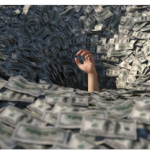October has been a rough month for the stock market with the recent downdraft wiping out index gains for the entire year. The deterioration has been rapid despite a strong earnings season and overall S&P earnings increasing by nearly 30 percent. It is highly unusual for earnings and stock prices to diverge to this extent. Something is obviously deeply troubling investors, and we wonder if the Fed is triggering the start to the next bear market?
Fed is tightening
At the end of an economic expansion, the Fed tightens monetary policy so the economy doesn’t overheat. This time is no different. The Fed has hiked rates three times this year and is expected to hike one more time in December.
Furthermore, the Fed has been slowly reducing the size of its balance sheet by not re-investing bond maturities. Obviously, the Fed does not want to cause a problem. However, it should be noted that it is an grand and unprecedented experiment to shrink its $4 trillion balance sheet which was just $800 million in 2008.
Back in May, the Fed was allowing $6 billion of mortgage backed securities (MBS) and $4 billion of Treasuries to run off each month. The Fed will increase this every three months with a cap of $20 billion in MBS and $30 billion in Treasuries per month.

Tightening into slowing growth
The market seems to be digesting the possibility of 4 more interest rate hikes in 2019 while the market had been pricing in roughly 2. Since the end of September, monetary policy expectations have tightened significantly as measured by Goldman Sachs (see chart below).
This tighter monetary policy is in the face of slowing growth in Europe and Asia. Despite this fact, the ECB recently confirmed its plan to end the ECB’s 2.5 trillion Euro bond-buying program in December.

Repricing of assets
While we believe higher risk-free rates are great for savers, on a relative basis, the market has to reprice all risk assets. In simple terms, those that chased dividend yield stocks for 2-3% payouts in a zero rate environment can and probably will sell those same stocks to own a Treasury bill yielding 3% with no downside risk.













Leave A Comment